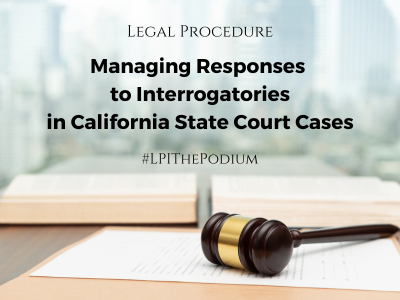
If you have been working in litigation for any length of time, you know that the discovery phase of a case is a very important part of the case. Discovery is the formal process of exchanging information between the parties about the witnesses and evidence to be presented at trial. The discovery process is designed to prevent “trial by ambush.” It is important to be familiar with the discovery processes in the areas of law that we work in and to be especially mindful of the deadlines involved. This month we will review the process of responding to interrogatories in California State Court cases.
Interrogatories are formal questions asked by one party in a case to another. Answers must be as complete and straightforward as possible, and the answers must be given under oath. (Cal. Code Civ. Proc. § 2030) Responses are due within 30 days of the date of service.
The Judicial Council provides several types of Form Interrogatories to be used depending on the type of litigation you are engaged in. For unlimited civil cases, a party may propound up to 35 special interrogatories. It is possible to propound additional interrogatories by serving a declaration explaining the need for the additional questions, and a statement that the request is not done for an improper purpose.
When interrogatories are received in your office, it is important to immediately note the due date of the response. A set of responses to interrogatories is prepared as a pleading, with a listing of the names of the propounding and responding parties, and the set number under the case caption. It is customary in preparing responses to list the interrogatory with the response under it. The receipt of a set of interrogatories is a great opportunity to be proactive in your attorney’s handling of the case, as most are appreciative if a draft responsive document can be started right away. If the case is similar to one you have worked on in the past, it can be helpful to pull together some standard objections into the draft. Setting up the draft document early on, with the interrogatories, a space for the answer, and perhaps a standard “General Objection” will give the attorney a head start on preparing a response.
Responses to interrogatories are typically verified by the party or its representative, assuming there are substantive responses and not simply objections. The language in the verification simply states that the declarant has read the document, knows the contents in it, and verifies that the matters are true of the declarant’s own knowledge, or are stated on information and belief. Once the response to interrogatories is finalized, it is served on all parties. It is not filed with the Court.
If the party receiving the responses to interrogatories believes that those responses are evasive or incomplete, or that an objection is without merit, that party may bring a motion to compel. Prior to such a motion, however, the parties must meet and confer to try to come to an agreement regarding the scope of the responses. Any motion filed must be accompanied by a meet and confer declaration. (California Code Civ. Proc. § 2016.040)
Next month, we will take a look at the requirements for interrogatory responses in federal court cases.
Categorized in: Legal Procedure
| << previous | next >> |








